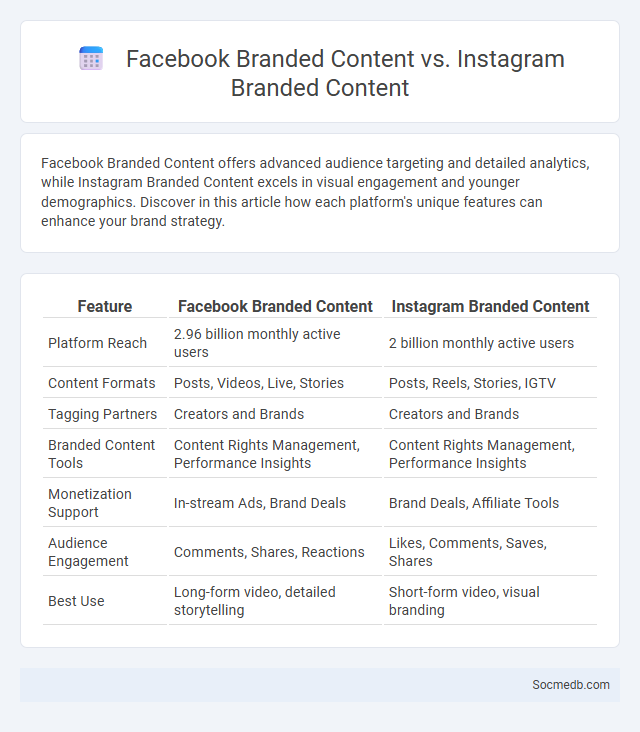
Photo illustration: Facebook Branded Content vs Instagram Branded Content
Facebook Branded Content offers advanced audience targeting and detailed analytics, while Instagram Branded Content excels in visual engagement and younger demographics. Discover in this article how each platform's unique features can enhance your brand strategy.
Table of Comparison
| Feature | Facebook Branded Content | Instagram Branded Content |
|---|---|---|
| Platform Reach | 2.96 billion monthly active users | 2 billion monthly active users |
| Content Formats | Posts, Videos, Live, Stories | Posts, Reels, Stories, IGTV |
| Tagging Partners | Creators and Brands | Creators and Brands |
| Branded Content Tools | Content Rights Management, Performance Insights | Content Rights Management, Performance Insights |
| Monetization Support | In-stream Ads, Brand Deals | Brand Deals, Affiliate Tools |
| Audience Engagement | Comments, Shares, Reactions | Likes, Comments, Saves, Shares |
| Best Use | Long-form video, detailed storytelling | Short-form video, visual branding |
Introduction to Branded Content
Branded content integrates marketing messages into engaging narratives that resonate with target audiences on social media platforms. It enhances brand visibility by creating authentic experiences that foster emotional connections and drive consumer engagement. Leveraging storytelling techniques and data-driven insights, brands craft content that aligns with users' interests, boosting reach and conversion rates.
Facebook Branded Content Overview
Facebook Branded Content enables creators and businesses to collaborate by sharing promotional posts that are clearly marked to comply with advertising policies, enhancing transparency and trust with users. Your brand can leverage this tool to reach targeted audiences effectively while maintaining the authenticity of sponsored posts through native integrations like product tags and swipe-up links. Utilizing Facebook's Branded Content tools boosts engagement and drives measurable results by connecting your campaigns directly with interested followers in a seamless, user-friendly environment.
Instagram Branded Content Overview
Instagram branded content enables creators and businesses to collaborate by showcasing sponsored posts that highlight products or services while maintaining authentic engagement with their audience. This feature helps your brand increase visibility, drive conversions, and build trust through transparent partnerships using Instagram's native tools like the Branded Content tag. Leveraging Instagram's powerful analytics allows you to measure campaign performance and optimize future collaborations for maximum impact.
Key Differences: Facebook vs Instagram Branded Content
Facebook offers robust tools for branded content with detailed analytics and a wide range of ad formats suitable for both long-form posts and videos, while Instagram emphasizes visually-driven branded content through Stories, Reels, and influencer partnerships targeting younger audiences. Your brand's engagement can benefit from Facebook's comprehensive targeting and community-building features, compared to Instagram's high-impact visual storytelling and influencer-driven reach. Choosing between Facebook and Instagram branded content depends on your campaign goals, with Facebook excelling in detailed performance insights and Instagram thriving in creative visual engagement.
Content Formats and Creative Options
Social media platforms offer diverse content formats including images, videos, stories, reels, carousels, and live streams, each optimized for user engagement and mobile consumption. Creative options such as augmented reality filters, interactive polls, shoppable posts, and branded hashtags enable brands to enhance user interaction and drive brand awareness. Leveraging platform-specific tools like Instagram Reels and TikTok's video editing features maximizes reach and fosters authentic audience connections.
Audience Targeting Capabilities
Social media platforms offer advanced audience targeting capabilities that enable businesses to reach specific demographics based on age, location, interests, and behavior. Tools like Facebook Ads Manager and Instagram Insights utilize machine learning algorithms to analyze user data, optimizing ad delivery for maximum engagement and conversion. Precise targeting increases ad relevance, reduces costs, and improves return on investment by focusing on users most likely to respond.
Engagement Metrics and Performance Analysis
Tracking engagement metrics such as likes, comments, shares, and click-through rates provides critical insights into how your audience interacts with social media content. Analyzing performance data enables you to identify trends, optimize posting strategies, and tailor content to maximize reach and user interaction. Your ability to effectively measure these metrics directly impacts the growth and success of your social media campaigns.
Compliance and Disclosure Requirements
Social media platforms demand strict adherence to compliance and disclosure requirements to ensure transparency and protect consumer rights. Businesses must clearly disclose sponsored content and endorsements according to Federal Trade Commission (FTC) guidelines to avoid legal penalties and maintain trust. Accurate representation of promotions and data privacy practices is crucial for regulatory compliance across global jurisdictions.
Best Practices for Branded Content Success
Effective branded content on social media hinges on authentic storytelling that aligns with the brand's core values and audience interests. Utilizing data-driven insights to tailor content formats and publishing times maximizes engagement and reach. Consistent brand voice combined with interactive elements such as polls, user-generated content, and influencer partnerships fosters community trust and long-term loyalty.
Choosing the Right Platform for Your Brand
Selecting the ideal social media platform for your brand hinges on understanding your target audience's demographics and preferences, such as age, location, and interests. Brands targeting younger audiences may find Instagram and TikTok more effective, while LinkedIn suits B2B marketing and professional networking. Analyzing platform-specific engagement metrics and content formats ensures your marketing efforts align with user behavior, maximizing reach and conversion potential.
 socmedb.com
socmedb.com